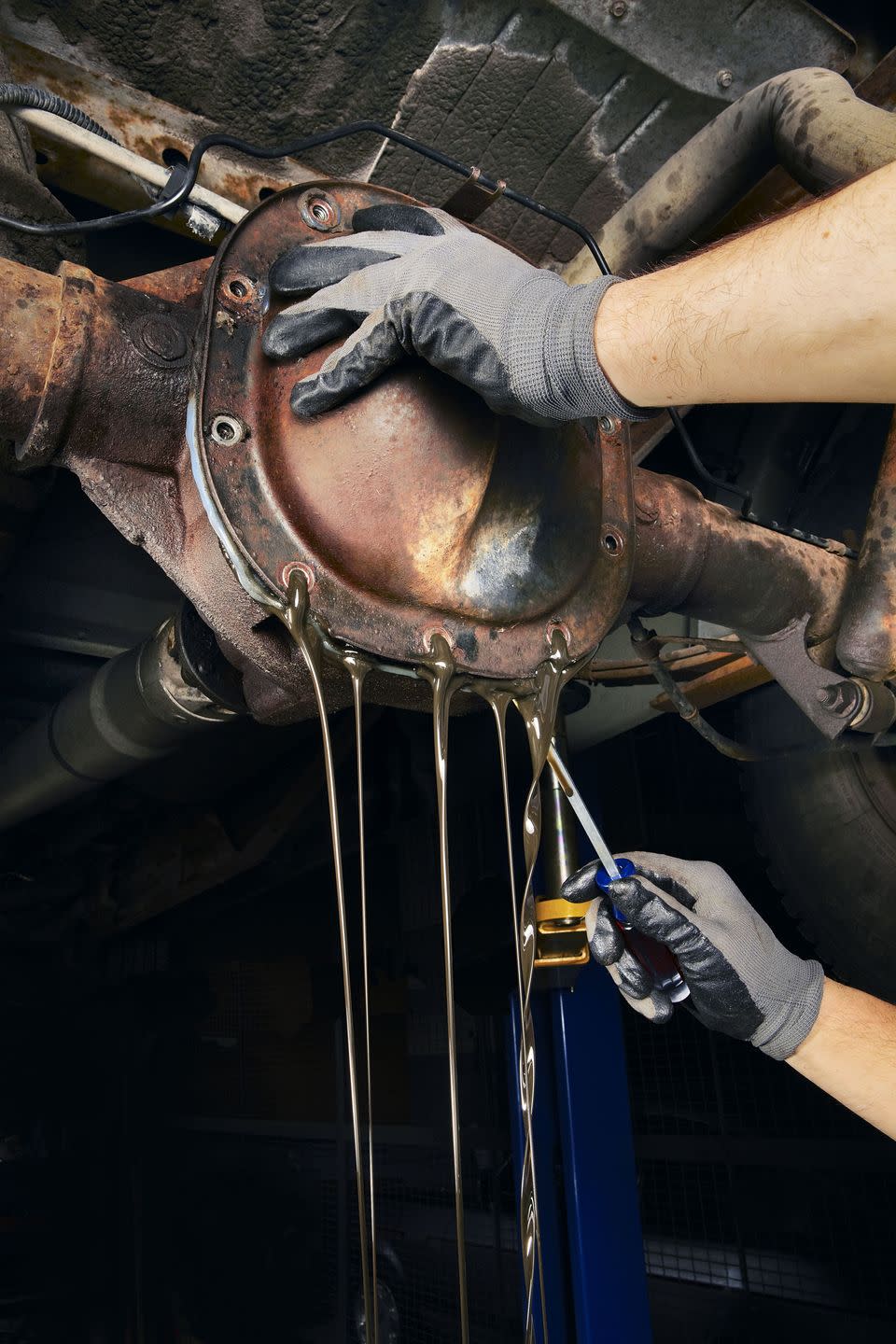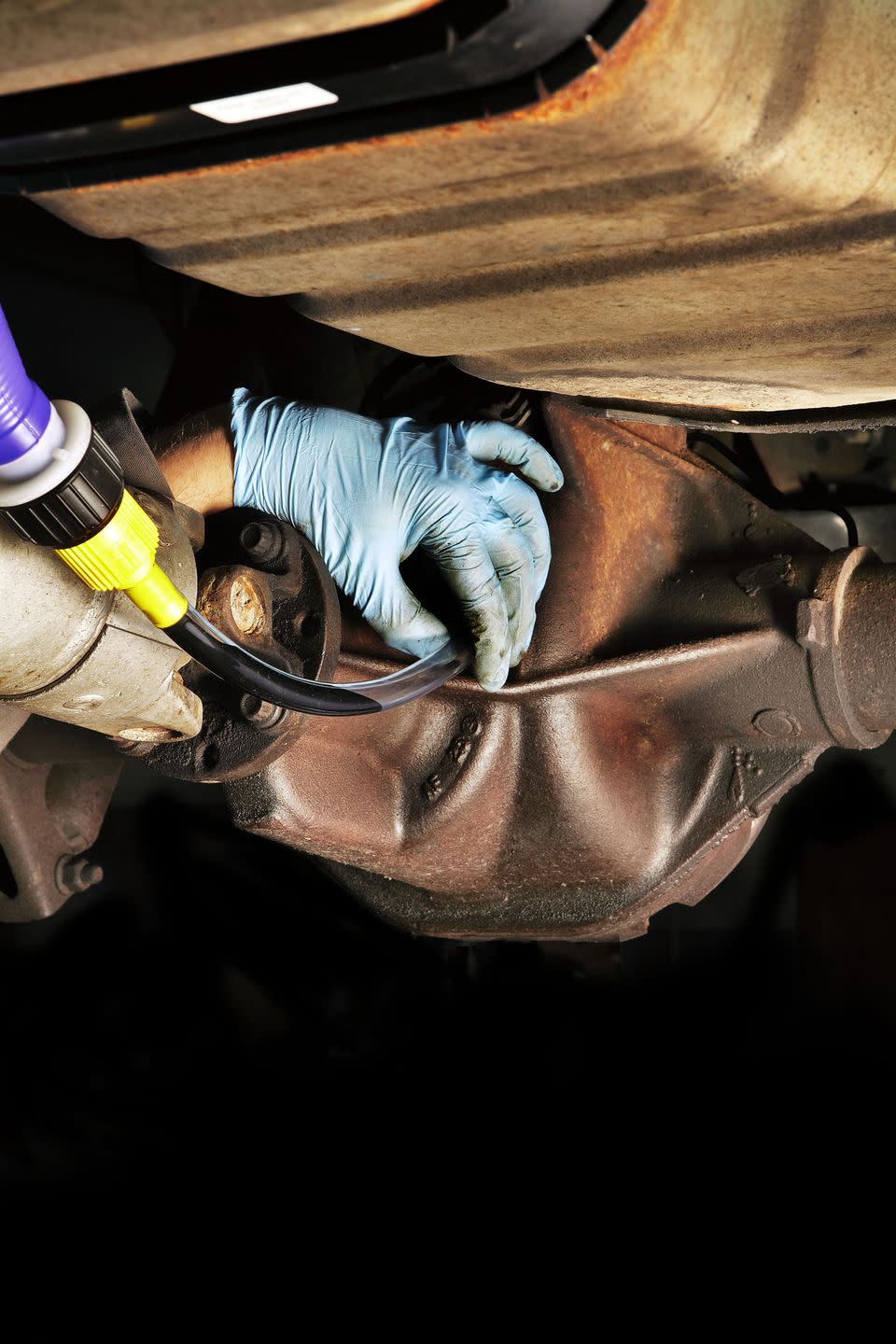You Change Your Engine Oil Every Few Thousand Miles, But Have You Ever Looked at Your Differential?
"Hearst Magazines and Yahoo may earn commission or revenue on some items through the links below."
Changing the car differential oil—it's one of the most-overlooked maintenance tasks on non-FWD light trucks, SUVs, and passenger cars. Because the differential is at the rear and under the car, it gets none of the star treatment that the engine up front does.
But if lubrication in the car differential fails, you won't be getting very far for very long. Fortunately, you only need to change this oil every 30,000 to 50,000 miles.
⚠️As always, check your owner's manual for the exact frequency you should service your differential. Every car is different.
The differential is a component in all cars and is designed to compensate for the difference in distance the inner wheels and outer wheels travel as the car goes around a corner. In a rear-wheel-drive car, the differential has its own housing and lubrication, a thick, dark oil usually heavier than 80 weight.
🔨 You love DIY projects. So do we. Let's build something cool together.
Front-drivers typically integrate the differential in the transmission housing and share the same fluid. The differential oil lubricates the ring and pinion gears that transfer power from the driveshaft to the wheel axles. If your car is fitted with a limited-slip differential, it also keeps all the moving parts in that assembly healthy.
A differential allows your car to make corners without drama. If both drive wheels rotated together, they'd jump-skitter because the outside tire travels farther than the inside. There are many variations on the design, but they fall into three categories: open, limited-slip, and torque-vectoring.
Changing this oil is just as important as changing your engine's oil, and for the same reason. Metal-to-metal contact wears down surfaces and creates heat from friction, which inevitably weakens the gears and leads to failure. Checking and changing the differential oil in a light truck is actually pretty easy, and it's only a bit more difficult in a car.
In either case, this small procedure can save you a big headache down the road.
Prep the area

Depending on the design of your differential, this can be a very messy or a very tidy job. Some differentials have a drain plug; others require you to remove the housing cover. In either case, you'll need a wide catch pan; a plastic dropcloth beneath that would be good insurance. Drive your vehicle for a few minutes to warm the oil, then change into your grungy clothes—you'll probably get dirty.
It's just changing oil, right? Nothing that complicated, but brace yourself, because old car differential oil has the foulest smell in the automotive world. With that warning, remove the fill-hole plug at the top of the diff casing, then unscrew the drain plug. If you don't have a drain plug, unscrew the housing bolts, leaving a couple of bolts on top loosely attached to hold the cover in place.
Using a standard screwdriver, pry open the cover gently or the oil will gush out and cover you in that unholy stink. Be careful not to mar the surface of the differential housing. Let the oil drain completely, then remove the cover.
Clean Everything and Seal It Up
Assume that all the leftover oil in the axle is loaded with metal shavings. If you're an oil-changing Boy Scout, you don't have to worry about this, but the rest of us should take the time to wipe the remaining oil out of the housing, the gears, and the wet side of the housing cover. Make sure to get it all, because there could be some shavings hiding in the nooks and crannies.
💡A basic degreaser or just a series of shop towels is all that’s necessary to clean out the housing cover. Use gloves you won’t mind throwing away. Once the cover is shiny, run a magnet around the inside to pick up stray metal shavings.
Clean the tip of the fill-hole plug too; most are fitted with a magnet to grab fine metal particles. Don't go crazy with harsh cleaners—you wouldn't want the residue to affect your new oil. Grab a razor scraper or light abrasive pad and clear off the mating surface of both the housing and cover. Wipe down both faces using a lint-free shop towel and brake cleaner.
Some cars have pre-made gaskets. If not, use a liquid gasket product designed for harsh conditions and oil exposure, such as Permatex Ultra Black. Lay a single bead on the mating face of the cover and draw a circle around each mounting hole, then bolt the cover in place with just enough clamping force to flatten the bead. Let it harden according to the instructions, then tighten the bolts to your vehicle's specs with a torque wrench.
Fill to the Brim

Use the highest-quality gear oil you can afford to fill the differential. The weight and capacity will be listed in your owner's manual; your differential will usually hold as much as 3 quarts. Be sure to read that manual, though, because some limited-slip differentials require a secondary friction-modifying additive.
Fill the differential directly from the bottle if you've got clearance, but if space is tight, you can get a pump or extension hose to make the job easier. The bottom of the plug hole is the maximum fill line, so when oil starts dripping out, you're finished.
Install the plug, torque it to spec, and you're good for tens of thousands of miles.
Now watch this:
You Might Also Like

